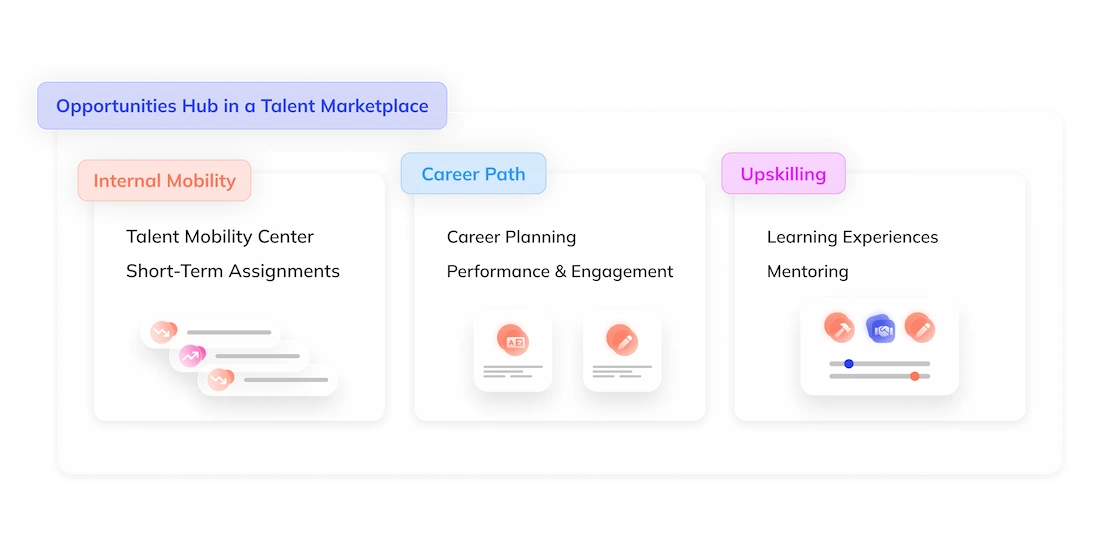Since the industrial era, work organisation has been structured around the concept of jobs, comprising fixed responsibilities and job descriptions that form the basis of remuneration and organisational hierarchies.
Is this model, with its emphasis on training, job titles and levels of experience, still suited to the shortage of skills employees in companies?
What does "organization focused on skills" mean?
A skills -based organization is one that values the specific skills and skills of its employees over traditional measures such as job titles, educational background or years of experience.
Simply put, it means "focusing on what you can do and how well you can do it, rather than where you learned to do it or how long you've been doing it."
This new organization in everyday life:
Prioritize talent over titles:
Imagine a soccer team where selection is based not on players' reputations or previous clubs, but on their current playing ability, their current physical condition, and how their skills aligns with the team's strategy for the next match. In an organization based on skills, positions and promotions are awarded according to the specific skills and skills that individuals bring to the table, and not just according to their job title or professional career ladder.
Evaluate skills in action:
Think of a chef in a kitchen. What matters most is not where the chef got his culinary education, but how well he can cook, manage the kitchen and innovate recipes. skills -based organizations evaluate employees on their ability to perform tasks, solve problems and contribute to team goals, focusing on practical demonstrations of skill and aptitude.
Sacralize continuous development methods:
Imagine a video game where you can improve your character by learning new skills and skills, enabling you to take on different challenges as you progress. In an organization based on skills, employees are encouraged to continually develop new skills and adapt to new roles, making the workforce more flexible and responsive to change.
Focus HR policy on personalized careers:
Consider a music streaming service that recommends playlists based on your listening habits. Similarly, in a skills-based organization, career paths are personalized. Employees can move laterally across different roles or departments where their skills are needed and where they can develop, rather than following a predefined path up the corporate hierarchical ladder.
Naturally reinforcing diversity and inclusion:
Imagine a group project where each member is chosen for his or her unique ability to contribute, regardless of specialization or year of study. This approach values diversity, recognizing that a wide variety of skills and perspectives stimulates innovation and performance, and helps break down barriers to inclusion by focusing on what individuals can achieve.
Now let’s take a look at how to make this transition.
Define career development based on the skills
Career development criteria in figures
Two figures from the recent Deloitte survey fuel the need for evolution criteria to evolve:
- 63% of managers say that work in their organization is currently carried out in teams, or via projects outside their main job description.
- 81% say that work is increasingly carried out across traditional functional boundaries.
So, how can we persist in conceptualising employee advancement solely in a vertical manner? Factors such as the number of years in a position, academic qualifications or an individual’s confidence level should no longer be the sole criteria for talent recruitment or promotions. This is particularly relevant considering the growing scrutiny of skill levels in critical positions. Thomas Chamorro-Premuzic underlines this perspective in a provocative article highlighting the increasing need for humility in today’s management roles, particularly among men.
It transforms into a tool that facilitates ongoing dialogue between employees and managers, enabling continuous assessment of both individual and team performance. Ultimately, it leads to the swift identification of hidden insights and potential risks.
The transition to more objective developments
How can we objectively assess the capabilities of each individual?
Three dimensions aid in this transition, with the starting point being the level of expertise.
- Provide regular feedback, a topic developed in the article “Continuous feedback vs. annual interview.”
- Design a relevant skills mapping tool, detailed in the “making a mapping that mobilizes” page.
- Involve all stakeholders in updating the criteria based on skills, especially managers, as discussed in the section titled “How to involve managers in mobility.”
This will undeniably necessitate a comprehensive shift in mindset and the broader corporate culture. These changes, often substantial and challenging, will naturally encounter resistance, affecting how managers assess contributions at work and how HR provides daily support to workers.
Matching skills with the organisation's opportunities
How to make internal opportunities visible?
Currently, leaders and managers do not possess a comprehensive view of their employees' skills. On the other hand, employees lack visibility regarding the opportunities available within their organisation. Two figures highlight this dissonance:
- Only 18% of executives strongly agree that employees fully utilise their skills and abilities.
- 85% of HR respondents assert that organisations should establish more agile work structures to enhance agility and adapt more swiftly to market fluctuations.

The Talent Marketplace acts as the digital embodiment of skills-based strategies. For example, It fosters collaboration and knowledge sharing by connecting individuals with projects and mentorship opportunities throughout the organisation, effectively breaking down silos.
You can explore the comprehensive functionality of this new skills-based approach in our detailed guide: “Internal Talent Marketplace.”
How opportunity matchings work in practice
Within this talent management system, every employee can apply for an internal position that aligns with their career development aspirations. By examining the skills essential for the role, they can promptly pinpoint the areas where they require assistance. Subsequently, the Talent Marketplace, empowered by robust AI, suggests the necessary training to help them achieve their objectives.
Conversely, a team in need of specific experience for a project can now directly recruit the most suitable candidate from within the company. This benefits both individuals and projects, enhancing overall productivity within the organisation.
Thanks to this system, employees are no longer required to wait for full validation; they can commence a portion of the role they aspire to and gradually take on additional tasks over time. Collaboration with a mentor, for instance, facilitates the exchange of best practices between managers and reduces resistance to what might otherwise be perceived as the loss of workforce.
Rethink and develop an engaging concept of objectives
Performance objectives and development objectives
Performance is typically defined as the degree of accomplishment, at a specific point in time, concerning anticipated outcomes relative to the expended efforts and resources. Given that performance relies on various prerequisites, including skills, it is often more sustainable to prioritise the development of skills and progression over solely focusing on performance. This approach encourages active engagement and adaptability to environmental changes. Furthermore, it wholeheartedly supports a culture of continuous learning as the organisation allocates adequate time for these transformations.
Training is no longer a burden in parallel to the work to be done, but a goal in its own right for the employee.
An overhaul of the animation of objectives
Ultimately, this re-evaluation of objective-setting practices results in enhanced employee retention and significantly contributes to the company's employer brand.
In fact, 64% of employees surveyed by Deloitte express a stronger attraction to organisations that prioritise development goals over performance objectives. This indicates people’s desire to work in environments where they perceive the organisation is actively nurturing and value their growth and fostering the realisation of their collective performance potential.Rather than attempting to homogenize individuals by imposing standardised, production-focused objectives, skill-based development goals allow the unique qualities of each person to shine through in their interactions with the business and its domain.
It is now the responsibility of HR teams to collaborate with all stakeholders and to emphasise the numerous advantages of this change:
- Personalised career solutions: Our article “5 tips for individualizing careers” provides valuable insights.
- Enhanced agility in responding to various changes: Refer to our White Paper on HR agility.
- User experience that empowers employees to actively participate in their career development.
- Restored confidence in the organization’s ability to offer appropriate mobility opportunities.







